This past season, the Athletics’ Seth Smith passed career milestones for 2000 total PAs and 200 PAs as a pinch-hitter. Among all players meeting both those criteria since 1950, Smith is easily the majors’ most proficient pinch-hitter. Which is ironic, considering that pinch-hitting has declined to record lows, in terms of both frequency of use and the effectiveness of the strategy.
More on the decline of pinch-hitting after the jump.
Here are the majors’ top pinch-hitters on a career basis since 1950, with a minimum 2000 PAs, including at least 200 as a pinch-hitter. Players are ranked based on OPS difference as a pinch-hitter.
| Rk | Player | Split | G | OPStot | Diff ▾ | PA | PAtot | AB | R | H | 2B | 3B | HR | RBI | BB | SO | tOPS+ | ||||
|---|---|---|---|---|---|---|---|---|---|---|---|---|---|---|---|---|---|---|---|---|---|
| 1 | Seth Smith | as PH | 201 | .967 | .798 | .169 | 201 | 2300 | 168 | 30 | 53 | 12 | 5 | 6 | 40 | 29 | 45 | .315 | .413 | .554 | 142 |
| 2 | Alex Arias | as PH | 239 | .803 | .688 | .115 | 239 | 2010 | 206 | 27 | 66 | 14 | 2 | 1 | 35 | 20 | 34 | .320 | .380 | .422 | 133 |
| 3 | Ron Northey | as PH | 212 | .895 | .801 | .094 | 212 | 3566 | 170 | 21 | 48 | 7 | 1 | 9 | 61 | 37 | 19 | .282 | .401 | .494 | 124 |
| 4 | Kurt Bevacqua | as PH | 376 | .714 | .632 | .082 | 376 | 2398 | 318 | 28 | 82 | 20 | 2 | 4 | 79 | 46 | 55 | .258 | .343 | .371 | 126 |
| 5 | Cliff Johnson | as PH | 344 | .876 | .815 | .061 | 344 | 4603 | 277 | 48 | 69 | 9 | 0 | 20 | 73 | 59 | 60 | .249 | .378 | .498 | 115 |
| 6 | Derrick May | as PH | 202 | .772 | .717 | .055 | 202 | 2387 | 175 | 14 | 46 | 11 | 0 | 6 | 30 | 22 | 34 | .263 | .343 | .429 | 115 |
| 7 | Pat Kelly | as PH | 234 | .785 | .731 | .054 | 234 | 5013 | 202 | 28 | 53 | 14 | 1 | 6 | 39 | 30 | 64 | .262 | .355 | .431 | 115 |
| 8 | Rick Miller | as PH | 227 | .749 | .696 | .053 | 227 | 4440 | 191 | 23 | 54 | 10 | 3 | 0 | 29 | 32 | 35 | .283 | .382 | .366 | 115 |
| 9 | Greg Colbrunn | as PH | 260 | .850 | .799 | .051 | 260 | 3017 | 229 | 29 | 71 | 11 | 0 | 9 | 48 | 20 | 51 | .310 | .375 | .476 | 114 |
| 10 | Dave Philley | as PH | 327 | .760 | .711 | .049 | 327 | 7004 | 298 | 36 | 92 | 19 | 1 | 2 | 57 | 25 | 49 | .309 | .361 | .399 | 114 |
| 11 | Mike Aldrete | as PH | 302 | .777 | .733 | .044 | 302 | 2498 | 253 | 36 | 65 | 10 | 2 | 9 | 50 | 42 | 51 | .257 | .358 | .419 | 112 |
| 12 | Jose Pagan | as PH | 231 | .685 | .641 | .044 | 231 | 4032 | 208 | 18 | 56 | 11 | 0 | 4 | 34 | 14 | 43 | .269 | .306 | .380 | 113 |
| 13 | Dalton Jones | as PH | 351 | .681 | .639 | .042 | 351 | 2556 | 309 | 35 | 81 | 11 | 3 | 3 | 52 | 34 | 65 | .262 | .334 | .346 | 114 |
| 14 | Marlon Anderson | as PH | 343 | .744 | .705 | .039 | 343 | 3508 | 309 | 50 | 84 | 15 | 0 | 9 | 46 | 30 | 63 | .272 | .336 | .408 | 111 |
| 15 | Earl Torgeson | as PH | 264 | .842 | .803 | .039 | 264 | 6046 | 209 | 36 | 57 | 8 | 1 | 7 | 46 | 53 | 41 | .273 | .420 | .421 | 110 |
Looking just at pinch-hitting OPS instead of OPS difference (sorry, OPS+ is not available in P-I’s Split Finder), some more familiar names appear, but Smith again tops the list with room to spare (and probably still would if OPS+ was available).
| Rk | Player | Split | G | OPStot | PA | PAtot | AB | R | H | 2B | 3B | HR | RBI | BB | SO | tOPS+ | ||||
|---|---|---|---|---|---|---|---|---|---|---|---|---|---|---|---|---|---|---|---|---|
| 1 | Seth Smith | as PH | 201 | .967 | .798 | 201 | 2300 | 168 | 30 | 53 | 12 | 5 | 6 | 40 | 29 | 45 | .315 | .413 | .554 | 142 |
| 2 | Ron Northey | as PH | 212 | .895 | .801 | 212 | 3566 | 170 | 21 | 48 | 7 | 1 | 9 | 61 | 37 | 19 | .282 | .401 | .494 | 124 |
| 3 | Cliff Johnson | as PH | 344 | .876 | .815 | 344 | 4603 | 277 | 48 | 69 | 9 | 0 | 20 | 73 | 59 | 60 | .249 | .378 | .498 | 115 |
| 4 | Greg Colbrunn | as PH | 260 | .850 | .799 | 260 | 3017 | 229 | 29 | 71 | 11 | 0 | 9 | 48 | 20 | 51 | .310 | .375 | .476 | 114 |
| 5 | Willie McCovey | as PH | 302 | .848 | .889 | 302 | 9692 | 259 | 33 | 68 | 9 | 1 | 16 | 84 | 39 | 61 | .263 | .358 | .490 | 91 |
| 6 | Earl Torgeson | as PH | 264 | .842 | .803 | 264 | 6046 | 209 | 36 | 57 | 8 | 1 | 7 | 46 | 53 | 41 | .273 | .420 | .421 | 110 |
| 7 | Matt Stairs | as PH | 490 | .833 | .832 | 490 | 6024 | 416 | 72 | 105 | 20 | 2 | 23 | 87 | 64 | 109 | .252 | .357 | .476 | 100 |
| 8 | Bob Cerv | as PH | 238 | .827 | .820 | 238 | 2515 | 206 | 32 | 55 | 11 | 0 | 11 | 51 | 26 | 47 | .267 | .346 | .481 | 102 |
| 9 | Merv Rettenmund | as PH | 305 | .824 | .786 | 305 | 3074 | 239 | 39 | 66 | 15 | 0 | 5 | 39 | 59 | 40 | .276 | .422 | .402 | 110 |
| 10 | Harold Baines | as PH | 222 | .814 | .820 | 222 | 11092 | 192 | 29 | 60 | 7 | 3 | 3 | 49 | 26 | 44 | .313 | .387 | .427 | 100 |
| 11 | Smoky Burgess | as PH | 577 | .812 | .808 | 577 | 5012 | 489 | 71 | 138 | 27 | 0 | 16 | 144 | 74 | 42 | .282 | .376 | .436 | 102 |
| 12 | Jason Giambi | as PH | 210 | .807 | .919 | 210 | 8838 | 173 | 22 | 41 | 3 | 0 | 11 | 36 | 31 | 62 | .237 | .362 | .445 | 76 |
| 13 | Alex Arias | as PH | 239 | .803 | .688 | 239 | 2010 | 206 | 27 | 66 | 14 | 2 | 1 | 35 | 20 | 34 | .320 | .380 | .422 | 133 |
| 14 | Orlando Merced | as PH | 381 | .798 | .781 | 381 | 4532 | 327 | 48 | 87 | 22 | 2 | 11 | 70 | 46 | 73 | .266 | .352 | .446 | 104 |
| 15 | Johnny Grubb | as PH | 272 | .793 | .779 | 272 | 4823 | 226 | 38 | 59 | 7 | 2 | 9 | 43 | 38 | 38 | .261 | .364 | .429 | 103 |
If you’re wondering about players with 200 pinch-hit PAs in fewer than 2000 career PAs, only Ryan Spilborghs (.837) and George Crowe (.810) would crack the list above. Wallace Johnson has the highest proportion of career PAs as a pinch-hitter (min. 200 pinch-hit PAs) at 53.9%, with a .692 OPS in 339 pinch-hit appearances among only 629 career PAs.
And, for players used most frequently as pinch-hitters, some more different names.
| Rk | Player | Split | G | PA | AB | R | H | 2B | 3B | HR | RBI | BB | SO | tOPS+ | ||||
|---|---|---|---|---|---|---|---|---|---|---|---|---|---|---|---|---|---|---|
| 1 | Lenny Harris | as PH | 883 | 883 | 804 | 84 | 212 | 36 | 4 | 5 | 90 | 63 | 91 | .264 | .317 | .337 | .654 | 96 |
| 2 | Mark Sweeney | as PH | 799 | 799 | 679 | 84 | 175 | 38 | 0 | 15 | 102 | 99 | 175 | .258 | .353 | .380 | .733 | 100 |
| 3 | Greg Gross | as PH | 733 | 733 | 595 | 53 | 143 | 15 | 5 | 0 | 64 | 117 | 48 | .240 | .362 | .282 | .644 | 78 |
| 4 | Dave Hansen | as PH | 703 | 703 | 593 | 62 | 139 | 22 | 3 | 15 | 81 | 104 | 153 | .234 | .348 | .358 | .705 | 94 |
| 5 | John Vander Wal | as PH | 624 | 624 | 533 | 70 | 126 | 33 | 4 | 17 | 95 | 87 | 153 | .236 | .342 | .409 | .751 | 90 |
| 6 | Manny Mota | as PH | 592 | 592 | 497 | 69 | 149 | 16 | 3 | 4 | 115 | 61 | 47 | .300 | .373 | .368 | .741 | 100 |
| 7 | Smoky Burgess | as PH | 577 | 577 | 489 | 71 | 138 | 27 | 0 | 16 | 144 | 74 | 42 | .282 | .376 | .436 | .812 | 102 |
| 8 | Orlando Palmeiro | as PH | 525 | 525 | 456 | 69 | 120 | 24 | 2 | 3 | 49 | 50 | 65 | .263 | .337 | .344 | .682 | 94 |
| 9 | Jim Dwyer | as PH | 501 | 501 | 419 | 54 | 101 | 17 | 2 | 10 | 74 | 67 | 78 | .241 | .339 | .363 | .702 | 87 |
| 10 | Gates Brown | as PH | 499 | 499 | 422 | 66 | 106 | 14 | 5 | 16 | 73 | 70 | 59 | .251 | .357 | .422 | .779 | 109 |
| 11 | Terry Crowley | as PH | 494 | 494 | 423 | 47 | 109 | 19 | 1 | 5 | 69 | 63 | 51 | .258 | .350 | .343 | .693 | 93 |
| 12 | Matt Stairs | as PH | 490 | 490 | 416 | 72 | 105 | 20 | 2 | 23 | 87 | 64 | 109 | .252 | .357 | .476 | .833 | 100 |
| 13 | Greg Norton | as PH | 489 | 489 | 413 | 47 | 96 | 21 | 2 | 13 | 73 | 72 | 122 | .232 | .348 | .387 | .735 | 95 |
| 14 | Jerry Lynch | as PH | 487 | 487 | 430 | 55 | 114 | 13 | 3 | 18 | 90 | 51 | 90 | .265 | .344 | .435 | .779 | 98 |
| 15 | Jose Morales | as PH | 486 | 486 | 446 | 45 | 123 | 24 | 3 | 12 | 93 | 31 | 86 | .276 | .324 | .424 | .747 | 101 |
That Lenny Harris would top this last list is very telling. This is a player with a career .667 OPS who only twice passed 100 OPS+ (at 102 and 103) in 15 seasons of 100+ PA. And, it’s not like he had a particular knack for the job, as he wasn’t able to match even that very modest OPS performance as a pinch-hitter. Yet, major-league managers thought he was the team’s best available option for almost 900 PA. How sad.
So, how did pinch-hitting decline to the point where the likes of Lenny Harris would be the majors’ all-time leader in pinch-hit appearances? The answer probably isn’t a surprise. The ever-increasing use of relief pitchers has led to bloated pitching staffs and shorter benches. Benches so short, in fact, that there’s not room anymore for a pinch-hitting specialist (much less a left-hand hitting and right-hand hitting pinch-hit specialist, as was common 30 or 40 years ago). Certainly not after the roles of reserve catcher, reserve infielder and reserve outfielder have been filled (what a marvelous luxury today to have a player fill one of those roles and also be an effective pinch-hitter).
A picture tells a thousand words, so let’s go right to the charts.
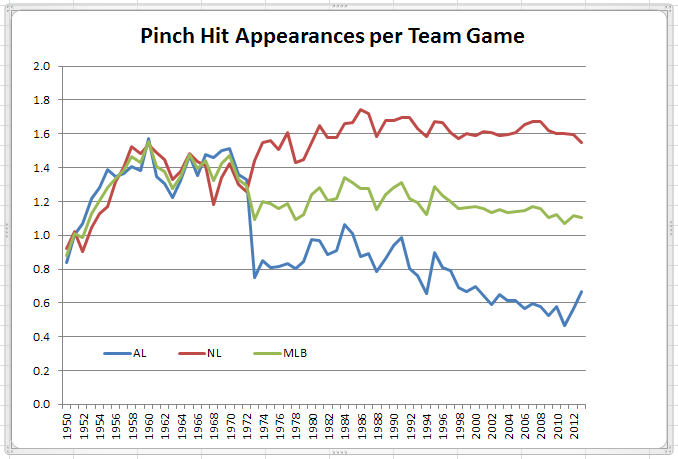
So, the leagues were pretty much in lock step until the AL numbers predictably fell off the table when the DH was introduced. Then, both leagues stayed fairly stable until the AL began a steady decline in the early 1990s.
So, you might think the decline of the pinch-hitter is just an AL thing? Let me add another line to the chart and we’ll see if you still think so.
The only thing falling faster than AL pinch-hit appearances are NL starting pitchers lasting deep into games. Given that context, NL pinch-hit appearances should have risen substantially. Except they couldn’t because the bodies on the bench aren’t there. Thus, the ever-increasing use of the double-switch as a more bench-effective substitute for pinch-hitting for the pitcher.
So, less pinch-hitting. But, what about the effectiveness of pinch-hitting as a strategy? Sorry, more bad news.
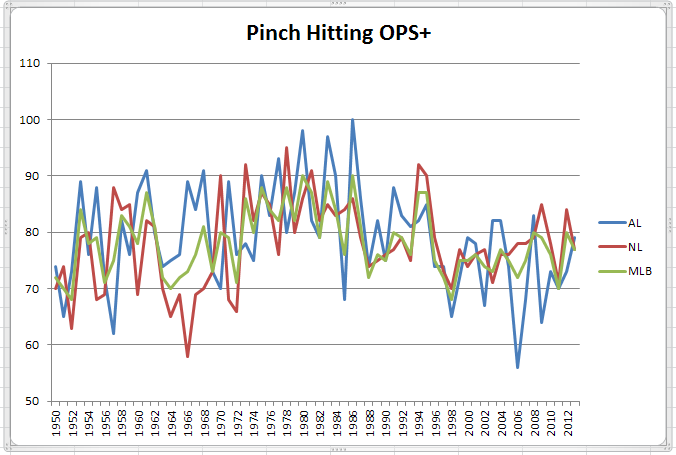
Since peaking at close to league average performance in the mid-1980s, pinch-hitting OPS+ performance has declined to the point where the guy coming up to bat (unless it’s the pitcher) couldn’t be any worse (and is probably quite a bit better) than any available pinch-hitter, particularly in the AL. And, the NL performance isn’t a lot better, especially considering it’s measured against a league average that includes pitchers’ batting. So, no real surprise that managers are using fewer pinch hitters.
But, why are pinch-hitters performing so poorly? Aside from the fact that few pinch-hitters specialize in that role, there’s this.
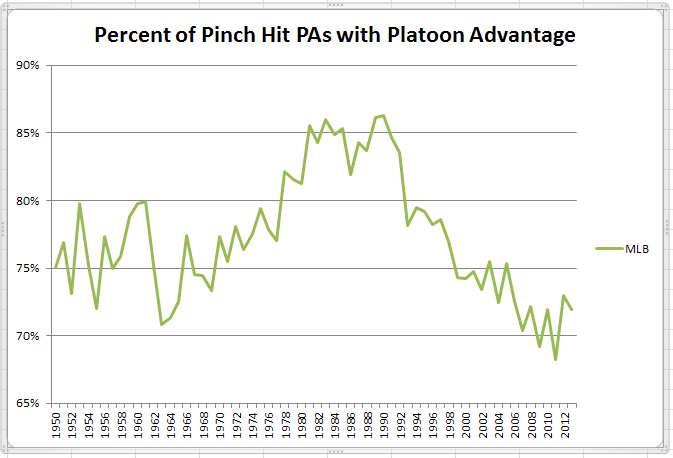
Sorry there are no league totals in P-I’s event finder, but you get the idea. With huge pitching staffs and tiny benches, the defense has the upper hand in pinch-hitting matchups (an advantage only slightly diminished by today’s practice of having rigidly defined pitching roles in the 8th and 9th innings).
One more indicator of the lack of pinch-hitting options available to today’s managers.
Yup, the old cat-and-mouse game of sending up the “sacrificial” pinch-hitter with the expectation that that will result in the other manager going to his bullpen. Has never really happened as much as you might think – at its peak, maybe 5 or 6 times a season per team. But, it’s all but disappeared from the AL today, at less than once a season per team.

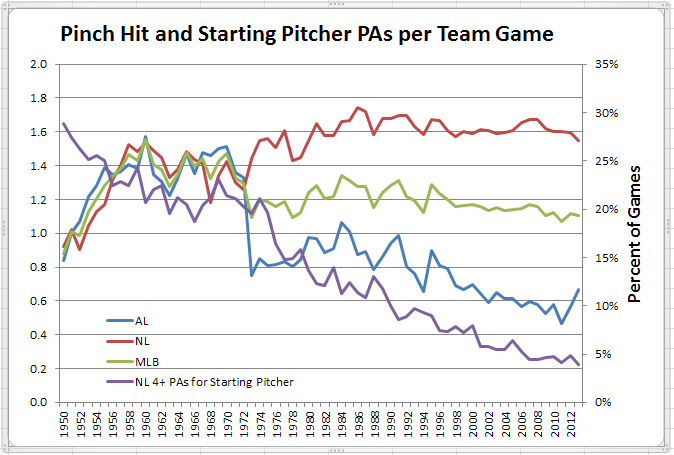
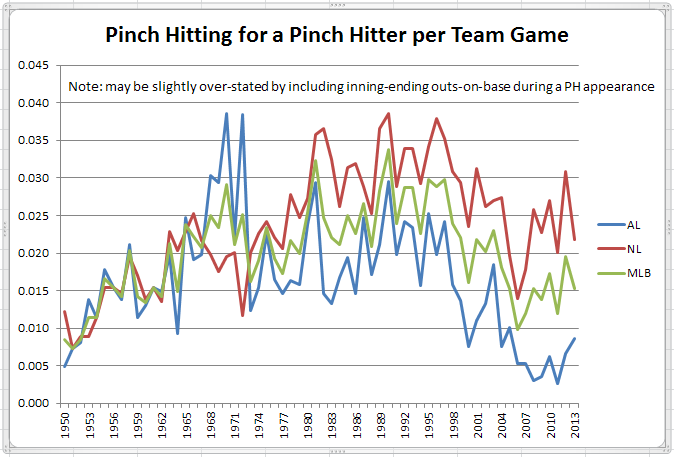
Looks like Dave Hansen holds the lifetime and seasonal records for sacrificial PH appearances. He was PH for as a PH 63 times career-wise. In 2003 he was PH for 13 times as a PH and there were no inning-ending outs-on-base.
Good find, Richard.
I’m guessing Hansen in 2003 also has the single season record for highest percentage of league total with 18.5% of the NL’s 70 PH appearances without a PA.
Hansen’s percentage was 13/71 = 18.31%. It’s not a record. Lenny Harris had 19.23% in 2005 and Dale Coogan had 20.00% in 1950. Prior to 1943 there were several seasons in which there were fewer than 6 player-games with 0 PH PA so obviously there had to be at least 1 player with at least 20.00% in each of those years. The results are for the NL only.
Richard,
Nice work again on Lenny Harris. The 1950 data are described in B-R as “mostly complete”, with data before then only spotty (apparently substitutes are not always shown with positions in the older boxscores; or they may be shown with a position signifying only that they appeared in the game in the field, but without precluding the possibility of having entered the game as a pinch-hitter).
Actually Richard, it was only 70 PH for PH appearances in the NL in 2003. The 71st that you noted was by Henry Blanco on Aug 20 who pinch-hit for Javy Lopez in the middle of Lopez’s 8th inning AB, and completed a strikeout that was charged to Lopez. Blanco remained in the game to catch the 9th inning, so appears as PH-C in the box score without a PA.
Thanks for the correction for the NL in 2003 but how did you pick that up about Blanco? Did you check each 2003 PH appearance individually?
I had clicked “Played exactly as marked or not” for the PH position and with PA=0 and found 70 occurrences for the NL in 2003. I used the “exactly” option as any pinch-hitter who was pinch-hit for could not have remained in the game and so would only appear in the boxscore as having been a pinch-hitter. This method will be 99% accurate, but can still be foiled by an aborted PA with an inning-ending caught stealing or pickoff (or an oddball appearance like Blanco’s, had Blanco not remained in the game).
When you said 71 games, I figured you had clicked “Played any of those marked” and picked up an extra game where the player stayed in the game after pinch-hitting (and, so, could not have been pinch-hit for). Looking at the position column in the list of games, it was easy to spot the one where the player stayed in the game.
Thanks Doug. That was very clever on your part.
Doug,
Some very nice analysis here.
A few comments:
1) To your second graph, the drop off in the NL 4+ PA games line does not seem out of proportion to the increase in the NL pinch hit PA per team game line. Bear in mind that these two metrics are graphed on different scales, and even in the early ‘70s team games with four pitcher PAs were somewhat rare (20%). The decrease to 5% in recent years represents only a marginal increase in the opportunity for pinch hitter PAs.
2) To your third graph, pinch hitter production has never been great. And to my eyes, it seems that any recent trends are subtle, at best. I suspect that if the MLB OPS+ numbers were graphed as 5-year rolling averages, the trend line would mostly reside between 75 and 85 OPS+.
3) Interesting that since 1990, there has been a steady decline in pinch hitter platoon advantage (your fourth graph), but this trend is not obviously coupled to a decrease in pinch hitter OPS+ (your third graph).
Thanks Brendan,
To your first point, perhaps 4+ PAs by a starting pitcher was not the right metric to illustrate the point, but I do think the decline in length of pitcher starts has tended to increase NL pinch-hitting, as seen from the early ’70s to the mid ’80s, and which has only been tempered since by the necessity of resorting to the double-switch instead of pinch-hitting.
Re: point 2 and 3, it’s difficult to see on the OPS+ chart but, if you look closely at the MLB (green) line, you’ll see it was between 80 and 90 in all but two years from 1973 to 1986, and below 80 in all but two years since 1987. I think that’s a meaningful drop that does correlate well with the platoon advantage chart which rose rapidly when OPS+ was in its higher range, and started its drop from peak levels about 1990, just after OPS+ dropped into its current lower range.
Seth Smith’s career BABIP as a pinch hitter: .392
Most of that is Coors, it would seem. Since coming to Oakland, Smith’s seasonal BABIP as a pinch-hitter has been .333 and .286.
Me too. I think his 132 tOPS+ in Coors Field is coming into play also.
It looks like Greg Gross was more a pinch walker in his career. Amazing how many walks he drew considering he had no power.
Good observation, Arsen.
Since Greg Gross conveniently had 733 pinch-hit PAs, a very full season’s worth, I looked for season lines with the most walks without a home run.
Among homerless seasons, only Eddie Stanky (137 BB in 1946) and Topsy Hartsel (121 in 1905) have more walks than Gross’s walk total of 116 as a pinch-hitter. And only Rabbit Maranville’s 746 PAs in 1922 (but with only 61 BB) exceed Gross’s pinch-hit PA total.
Generated 12/17/2013.
Two things:
I remembered Gross only as a name so I looked him up, and 1) he didn’t actually walk that much when he was not pinch hitting; 2) as a highly used pinch pinch hitter he was the worst at scoring runs and driving them in.
I’m a bit wary of the claim that Seth Smith would still top the pinch-hitting effectiveness list with room to spare if OPS+ were available; my inclination is to think that his years in Colorado trump his 70-point OPS advantage to a significant degree.
Smith is, though, still a pretty good hitter overall, and I remember never being able to figure out why the Rockies seemed to value him so lightly. He’s not a superstar by any means, but he’s decent with the bat, and they used to leave him on the bench in favor of the Dexter Fowlers and Eric Young Jr.s of the world. This never made sense to me. And then they traded him for nobody and nothing. I just don’t get it.
I suppose one could estimate the OPS+ as a pinch-hitter by multiplying the player’s career OPS+ by TOPS+ as a pinch-hitter.
Thus:
– Smith: 109 x 1.42 = 154.8
– Northey: 124 x 1.24 = 153.8
– Johnson: 125 x 1.15 = 143.8
– Colbrunn: 106 x 1.14 = 120.8
– McCovey: 147 x .91 = 133.8
We’d have to know what OBP and SLG an average offensive player would produce in every pinch-hit AB by these players, in that specific park and era, to know for sure. Then we could generate a lgSLG and lgOBP number for each player in their PH career to judge their individual pinch-hit SLG and OBP against.
But, for example, just using Seth Smith’s career lgSLG and lgOBP numbers and plugging in his PH OBP and SLG of .413 and .554, I get a 152.6 OPS+ for him, which would probably be a decent estimate as well.
Doug, on a tangent re: searching PH splits — When I try to replicate your first split table with the career minimum at 2,000 PAs, I’m not getting Alex Arias, which is a clearly faulty result; Arias had 2,010 PAs, with no sign of any unknown splits (as expected for a career spanning 1992-2002).
When I lower the threshold for career PAs, Arias does appear, shown with 1,897 PAs. The difference is 113 PAs, which happens to be his rookie total, when he batted only as a SS.
Checking my results further, I found slight discrepancies in some other players’ career PA totals on the same search: e.g., Derrick May shows 2,324 PAs instead of 2,387, and Rick Miller shows 4,398 instead of 4,440. In both cases, the difference equals their rookie total.
Have you noticed any such faulty results from the Split Finder?
P.S. You said the split tables are since 1950, but I think if that were so, Ron Northey would not qualify, having only 161 known PH PAs since 1950.
JA: I ran the PI and got the same results as Doug, except that Torgeson was listed above Anderson. Northey’s totals go back to 1946. The years 1946 to 1950 have incomplete results. His 1942 to 1944 PH stats can be retrieved from his batting game logs for those years.
Richard, I do get Doug’s results when I choose “Find Career Totals” for the PH split, with 2,000 career PAs and 200 as a PH. But if I choose “Find Totals Spanning Seasons” for 1950-2013, my results omit Arias, and have those other PA discrepancies that I mentioned.
John, I said since 1950 because that is the earliest that PI claims that the event data are “mostly complete”.
Northey gets picked up because, when running a career Split, P-I does not provide the option of limiting the data by season – you get everything P-I has.
The table is generated based on selecting the PH within Defensive Positions split with “Set minimums by season totals …” checked off and PA >= 2000 specified as a career filter, and then specifying PA >= 200 under “Select additional criteria …”.
John: I am on a mobile device now so navigation is difficult. Briefly perhaps when running spanning seasons the PI ignores seasons without a PH appearance.
JA: This is to confirm my statement of post 22. I ran the PI for careers and for spanning seasons. I checked Carlos Baerga’s stats. The career PI run shows 308 PH appearances and 5895 total PA. The spanning seasons run shows 308 PH appearances but with 4710 total PA. The difference in PA is 1185. I then checked his career splits on BR.There were two seasons, 1992 and 1994, in which he had no PH appearances. His total PA in those two seasons was 1185. So doing a spanning seasons PI run counts only the years in which had had at least one PH appearance.